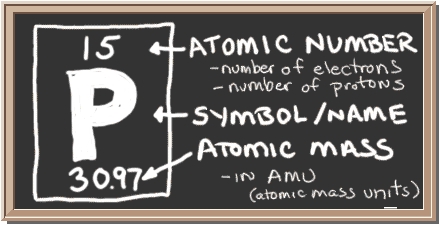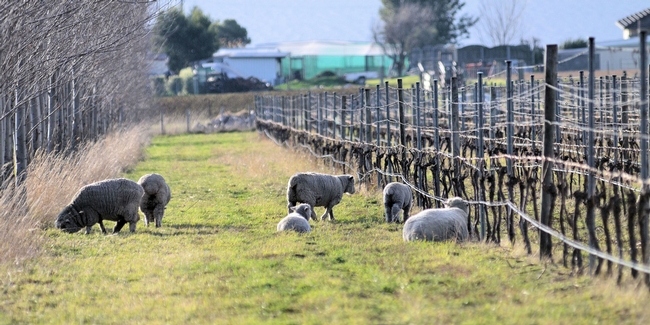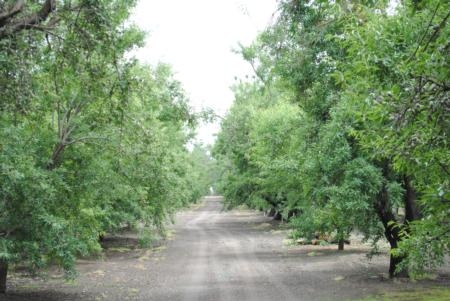Posts Tagged: nutrient
UCCE advisor helps dairy operators strike a delicate balance to protect groundwater
Over the last 20 years, UC research has shown that dairies in the San Joaquin and Sacramento valleys are potentially major contributors of nitrate and salts in groundwater. To maintain the quality of this irreplaceable natural resource, the California Water Resources Control Board has ramped up regulations to ensure that diary manure and wastewater application isn't contaminating the aquifer.
UC Cooperative Extension advisor Nick Clark is helping farmers in Fresno, Kings and Tulare counties work through the process and continue producing crops sustainably now and in the future. He was hired in 2015 as the agronomy and nutrient management advisor, a title that reflects the importance of understanding the nutrient cycle and extending information to producers. Three other UCCE advisors are also focused on nutrient management.
Clark is working with dairy farmers who are producing crops to feed their herds, as well as farmers who are producing agronomic crops – such as silage corn, forage sorghum, wheat, triticale, alfalfa, rye and oats – to sell to dairies.
“These farmers operate under the microscope of several agencies for complying with environmental regulations and ordinances,” Clark said. Clark informs growers about the fate of nutrients in plants and soil and rules in place to protect water quality, helping them stay in compliance with government regulations. “Water quality regulations are becoming more strict, more complex and more specific.”
At the same time, some of the finer details about nutrient availability are not yet well understood.
Working closely with Luhdorff and Scalmanini Consulting Engineers, a groundwater engineering and consulting firm, Clark and colleagues have set up research trials on four commercial dairies in the San Joaquin Valley and one semi-research dairy farm to replicate a variety of treatments.
“The idea is to take a much closer look at nitrogen cycling in soil and plants to develop precise data about when plant development allows the crop to take up nitrogen,” Clark said. “The nitrogen application needs to be made so it is in the form plants need when the plants can use it. Otherwise, there is an increased chance it can percolate below the root zone and, eventually, into groundwater.”
Nutrient cycling involves advanced science. The majority of nitrogen content of manure is bound up in an organic molecule, which is not plant available. Plants only take up mineral forms of nitrogen – ammonium or nitrate. When the manure is in the soil, its chemistry changes. Timing by which this happens, Clark said, is extremely variable. Composition of manure, air and soil temperature, soil moisture, and soil microbiota all come into play.
“The research is trying to elicit information for Central Valley dairy farmers as to the best time, best rate and methods of application in order to fertilize crops without losing nitrogen to the groundwater,” Clark said.
Another factor that dairy farmers will have to consider is the implementation of the Sustainable Groundwater Management Act. The law, passed by the California Legislature during the 2011-2016 drought, creates local agencies to monitor groundwater extraction and bring that into balance with groundwater replenishment.
Diary operators are facing these new groundwater quality and quantity regulations at the same time new pressures from climate change are impacting their operations. Clark and his colleagues are also addressing climate change mitigation, adaption and resilience.
“We are looking into alternative feed crops for dairies that might help reduce the amount of irrigation water required to grow crops without sacrificing animal nutrition and milk yield,” Clark said.
One promising option is sorghum. UC Cooperative Extension scientists Jennifer Heguy, Jeffery Dahlberg and Deanne Meyer have been collecting data for a number of years on the crop's nutritional value and impact on milk yield. Another potential feed crop is climate-resilient sugar beets.
“Sugar beets have been used in other parts of the United States and the world as cattle feed, but not as much in the San Joaquin Valley,” Clark said.
He is working with UC Cooperative Extension agronomy specialist Steven Kaffka and UCCE animal science specialist Peter Robinson to refine knowledge about sugar beet production under Central California conditions.
“Sugar beets grow readily in the winter in California, so we can take advantage of winter rainfall and a low irrigation requirement. That may help mitigate climate change impacts,” Clark said.
Climate change mitigation may also be achieved on dairy farms by modifying manure application timing and procedure. Applications of manure to cropland has an impact on emission of nitrous oxide, a greenhouse gas 300 times more potent than carbon dioxide. Reducing the amount of manure applications on cropland and incorporating manure solids into the soil may be ways for dairy farmers to reduce their facilities' greenhouse gas emissions.
“We need to know a whole lot more to help farmers to stay in compliance and to deal with farming under new constraints,” Clark said. “Our research objectives are never static, because everything is shifting so quickly.”
On the topic of vineyard nutrient management, farmers want to know about sheep
The UC Sustainable Agriculture Research and Education Program is working to build an online community for growers facing challenges and trying innovative approaches to how they manage nutrients on the farm. With the help of FarmsReach and Sustainable Conservation, we've been working to build up an online group based on nutrient management to discuss a wide array of practices. For two weeks in January, we hosted a discussion on nutrient management for vineyards, particularly in times of drought.
In a recent Capital Public Radio story on winemakers struggling with groundwater shortages this year, winemaker Chris Leamy said “the drought has helped to spur change and innovation.” When business as usual is not an option, farmers get creative. Through discussion, informational videos, and a tool kit of resources, farmers and UC advisors shared some of the creative ways that growers are adapting to water limitations and building healthy soil in their vineyards.
One discussion to rise to the surface throughout was the use of animals in vineyard systems. Farmers with experience running animals through their vineyards chimed in with valuable insights.
Some thoughts repeated by several growers were:
- Short breeds like babydoll sheep and tall cordons on vines make sheep less able to graze on the canopy. Some growers use electrified deterrents running parallel to the trellis to allow sheep to stay in the vineyard into the summer with no leaf damage. Growers who kept sheep in vineyards year round described eliminating mowing completely.
- Drip lines need to be tall enough to be out of reach from sheep.
- Move sheep frequently to prevent soil compaction.
- One grower runs chickens through the vineyard at the end of the season, but says to avoid the practice if shoot growth has been too vigorous — the added nutrients from the chickens may give vines an unwanted boost in the spring.
- Growers who use sheep in their vineyards describe significant nutrient inputs from sheep, some to the point of eliminating other fertilizers altogether.
You can follow more of the conversation here. The group of participants is growing (94 strong now!) and we'll be hosting future discussions on different topics. This project is hosted by UC SAREP as part of the Solution Center for Nutrient Management. You can join our mailing list to stay up-to-date with our activities, online discussions, and updates to our website.
Drought-focused soil nutrient management series offered for farmers online
Beginning in November, a free, drought-focused soil nutrient management series for farmers will be hosted online by the University of California Sustainable Agriculture Research & Education Program (UC SAREP), FarmsReach and Sustainable Conservation.
“Farmers and ranchers have to continually adapt their management of soil nutrients to changing conditions,” said Aubrey White, UC SAREP's communication coordinator. “Adaptation during this extreme drought presents a new challenge for growers and researchers alike. This forum dedicated to the issues farmers will face next season is an opportunity to share resources, research and ideas for success.”
Kicking off on Nov. 17, the Nutrient Management Solutions series will offer the agriculture community:
- Online presentations, videos or Q&A with farmers and UC Cooperative Extension advisors on nutrient management and soil fertility, with special focus on tree crops, grapes and dairy farms.
- Facilitated online discussions in the active FarmsReach Conversations, moderated by Series presenters. (Join the Nutrient Management Solutions Group in FarmsReach to participate.)
- A new “Soil Nutrient Management Toolkit” in FarmsReach, with selected practical resources and info sheets for farmers of all crop and product types.
The online series is part of the Solution Center for Nutrient Management—a growing resource for nutrient management research and information, online and in-person created by UC SAREP.
The presentations, videos and facilitated online Q&A will be hosted in three sections:
- Nov. 17-30 – Nutrient Management in Times of Drought: Tree Crops
- December (dates to be announced) – Nutrient Management in Times of Drought: Wine Grapes
- January (dates to be announced) – Nutrient Management in Times of Drought: Dairy Forage Crops
To get updates and announcements, or to share your ideas for the drought-focused Nutrient Management Solutions series, sign up for free at www.farmsreach.com. You can also go directly to the online group within FarmsReach, http://www.farmsreach.com/nutrient-mgmt-series, and follow news on Twitter at #AgSolutionCenter.
About UC SAREP
The University of California Sustainable Agriculture Research & Education Program (UC SAREP) a program in UC Division of Agriculture and Natural Resources, provides leadership and support for scientific research and education in agricultural and food systems that are economically viable, conserve natural resources and biodiversity, and enhance the quality of life in the state's communities. SAREP serves farmers, farmworkers, ranchers, researchers, educators, regulators, policy makers, industry professionals, consumers and community organizations across the state.
About FarmsReach
Founded in 2007, FarmsReach is a network that connects small- and medium-scale farms to the products, support and services they need to be successful. By partnering with farmer members and agriculture organizations, FarmsReach offers a growing suite of services that empower farmers to make better business decisions, access new markets, preserve the environment and strengthen rural communities.
About Sustainable Conservation
Sustainable Conservation partners with business, agriculture and government to find practical ways that the private sector can protect clean air, clean water and healthy ecosystems. The independent nonprofit organization leads powerful collaborations that produce lasting solutions and sustain the vitality of both the economy and the environment.
Learning My N-P-K's (part 2)
In my last blog, I talked about my struggle with the chemistry, the science of gardening, the bones that make it all work--not my forte. However, I decided to face it as a mature gardening adult, and learn, for starters, my N-P-Ks, those three mysterious numbers found on boxes of fertilizers and bottles of plant food. As I mentioned in my last blog (May 1), the first number listed stands for nitrogen, "N", which is essential for for healthy leaf growth. I discussed what your plants might look like if they were nitrogen deficient, and some suggestions to solve the problem.
Now we come to the second number, which informs the user of the percentage of phosphorus, "P", contained in the product inside.
I have been told (by a former science teacher, no less) that phosphorus has been used since WWI up through present day wars as a smoke tracer, an explosive, a poison and nerve gas, and has been called "the Devil's element". So why would I want this destroyer of life in my benign veggie garden? Well, it turns out that phosphorus comes in many forms and colors. It actually takes up 1 % of each one of our body weights, and is found in each cell of the human body without smoking or poisoning. It's primary use in our body, unlike in Vietnam, is the formation of bones and teeth. And just to prove to you phosphorus' versatility, it is the primary ingredient found on the head of a safety match. Believe me, this is all very confusing to a science dropout.
Phosphorus was actually discovered by a man from Munich, Germany named Hennig Brand in 1669, who found it while experimenting with urine, producing a product that actually gave off a pale green glow. He kept his method secret, as he, along with all alchemists of the day, was planning on turning his discovery into gold. He finally agreed to share his formula, and gardening has never been the same since.
But back to the question as to why any of us would want phosphorus in our gardens. Phosphorus is actually a mineral that is essential to metabolism. It is the principal element in the structure of the nucleus and cytoplasm of all tissue cells. Without it, as with nitrogen, plants do not thrive. Phosphorus is instrumental in aiding a plant convert needed nutrients into the useable building blocks that it needs to grow. If your plants are spindly, stunted in growth, have leaves that are blue/green with a purplish tinge, produce small fruit with an acid taste, or set very little fruit at all, you most likely have a phosphorus deficiency. Plants that are especially susceptible to this deficiency are carrots, lettuce, spinach, apples, currents, and gooseberries. The purplish tinge seen on the underside of tomato leaves indicates a "P" problem.
These deficiencies occur primarily in areas where there is a high level of rainfall, especially if the soil is acidic, clay, or poor chalk. Cold weather can also be a factor in the poor absorption of phosphorus.
The remedy is simple. Add organic material such as fish fertilizer as a soil drench, bone meal, colloidal phosphate or compost (food wastes are quite high in phosphorous). Also, the addition of rock phosphate is highly recommended. Edward C. Smith, author of The Vegetable Gardener's Bible, states that as phosphorus is most likely to be the nutrient missing from the soil, adding rock phosphate whenever you start a new garden is a wise move. He recommends 10 pounds per 100 square feet. Be forewarned, however. Plants that naturally adapt to low levels of available phosphate are more likely to suffer from phosphate poisoning. Aha! Back to a war reference.
Mr. Smith also makes another interesting point; do not be misled when you read numbers on the package of rock phosphate (0-4-0) that its phosphate contents is only 4%. That 4% represents the immediate available phosphorus. The product actually is about 30% phosphorus with more than 25% of it in a slow release that will become available over time.
We have one more letter to explore in our nutrient alphabet, and in my next blog I will discuss that third label number. Mmmmmm. Could "K" stand for "Kompost"?

Phosphorus symbol from the elemental chart. (graphic from www.blackdiamond.org)




